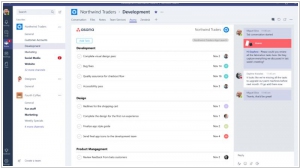Asana vs Facebook Workplace
August 10, 2023 | Author: Adam Levine
10
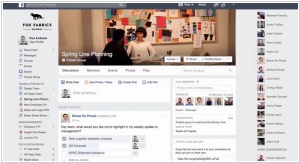
Facebook Workplace is business alternative to Facebook. Connect everyone in your company and turn ideas into action. Through group discussion, a personalised News Feed, and voice and video calling, work together and get more done. Workplace is an ad-free space, separate from your personal Facebook account.
Asana and Facebook Workplace are both popular collaboration and communication platforms, but they differ in their focus and key features. Asana is a project management tool that helps teams organize tasks, track progress, and collaborate on projects. It offers features such as task assignments, timelines, and integrations with other productivity tools. Asana is designed to streamline project workflows and improve team coordination. On the other hand, Facebook Workplace is a platform that aims to enhance internal communication and collaboration within organizations. It provides a familiar interface similar to Facebook, allowing teams to communicate through posts, groups, and direct messaging. Facebook Workplace emphasizes social interaction and community building within the workplace. While Asana focuses on project management and task-oriented collaboration, Facebook Workplace emphasizes internal communication and engagement.
See also: Top 10 Enterprise Social Software
See also: Top 10 Enterprise Social Software
Asana vs Facebook Workplace in our news:
2023. Asana launches new work intelligence tools with AI on the way
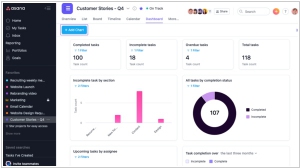
Asana has announced a new set of dashboards to give managers the data they need to make sure projects are staying on budget and meeting goals. This involves providing a single view of strategic initiatives, team capacity and budgets. It builds on the graph model that underlies the entire Asana platform, but the company is working to bring artificial intelligence to the process to make it even smarter. The next step will be using AI to generate the portfolios of the things that you care about instantaneously. So having them become smarter and smarter, but the fact that they can be at any level across an entire organization, that is part of this new launch
2020. Facebook’s Workplace, now with 5M paying users, adds drop-in video Rooms and more

Facebook has recently unveiled a range of new offerings for its enterprise-oriented chat and video platform, Workplace. These include Workplace versions of Rooms, a video drop-in feature similar to Houseparty, and Work Groups, which enable direct communication among colleagues in smaller groups outside of their wider circle of friends on Facebook. Notably, Workplace users will find the standout feature of Rooms particularly useful. It allows Workplace users to create links that can be accessed by others, even if they are not part of the user's Workplace group or on Facebook. This functionality resembles popular video conferencing platforms like Zoom, where a simple URL link grants entry to anyone with a camera, microphone, browser, and internet connection. Presently, Workplace boasts 5 million paying users, with millions more utilizing the platform for free.
2019. Facebook Workplace dives into enterprise video content management
To leverage the increasing emphasis on video within Facebook's consumer service, Facebook Workplace has taken several initiatives to enhance its own video capabilities. One notable step is the introduction of a dedicated app for the Portal, Facebook's video screen. Additionally, Workplace is introducing new video features, including captions displayed at the bottom of videos, automatic translation for 14 languages, and a new peer-to-peer (P2P) architecture that optimizes video transmission in bandwidth-constrained environments. These enhancements aim to differentiate the Workplace experience and demonstrate its suitability for businesses. While companies may already be using platforms like Slack, Workplace offers a compelling alternative or complement, encouraging businesses to consider adopting or migrating to this platform.
2018. Work management software provider Asana gets $50M
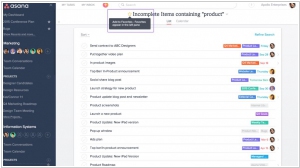
Asana, a platform utilized by teams and individuals to plan and monitor work projects, has secured an additional $50 million in funding, resulting in a valuation of $1.5 billion. The funding will be allocated towards international expansion and product enhancement. Asana has been actively focusing on global growth, with half of its new sales already originating from outside the United States. The company aims to further extend its product offerings while approaching profitability. As part of its expansion strategy, Asana plans to establish an AWS-based data center in Frankfurt within the first half of the upcoming year. Additionally, it intends to establish a stronger presence in the Asia-Pacific region, with new offices in Sydney and Tokyo, along with ongoing recruitment efforts in both markets. Asana's customer base spans across 195 countries and supports six languages. The company's decision to concentrate on these two regions stems from the significant traction it has observed in those areas.
2018. Asana launched $19.99 Business tier to help managers handle multiple projects
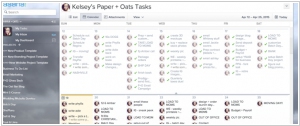
Project management service Asana is introducing a new tier called Asana Business, tailored for enterprises that handle multiple projects. Priced at $19.95 per user per month, this offering is specifically designed to support teams with managers or executives overseeing numerous projects simultaneously, which can sometimes reach thousands within a single organization. Asana Business provides additional features to aid designated individuals in effectively managing and prioritizing their workload. This emphasis on executives and managers aligns with Asana's broader vision of its role within the spectrum of productivity tools used by businesses. Alongside efficient storage solutions like Dropbox or Box and communication platforms such as Slack, Workplace, and Teams, Asana aims to establish its place as a comprehensive tool for enhancing organizational productivity.
2018. Facebook Workplace gets 50 new app integrations
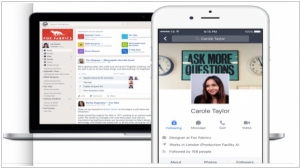
Facebook has expanded the capabilities of its Workplace business software by incorporating 50 additional app integrations. These integrations include popular platforms like ServiceNow, Atlassian's Jira Cloud, and Microsoft Sharepoint. Initially, Workplace offered only a few integrations such as Office 365, Salesforce, and OneDrive. With the introduction of these new integrations, Workplace is broadening its focus beyond collaboration to include automation and IT integration. Users can access these integrations through the newly introduced Workplace app discovery portal, which also features applications like SurveyMonkey, Cornerstone onDemand, Workday, and Smartsheet.
2018. Asana adds AI-powered interactive project maps
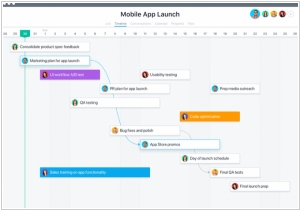
Workflow management platform Asana has introduced a new feature called Timeline, offering composite, visual, and interactive maps that illustrate the progress of various projects assigned to team members. This feature provides teams with a broader perspective on their collective workload and visualizes how projects interconnect in a timeline format. Timeline proves valuable in scenarios such as product launches, marketing campaigns, and event planning. Importantly, it does not require duplicating work or using separate software; instead, each project automatically becomes a distinct segment on the team's Timeline. It's worth noting that Timeline is exclusively available to paying users, while free users among Asana's extensive user base will need to upgrade to the premium tier to access this feature.
2018. Asana raised another $75M
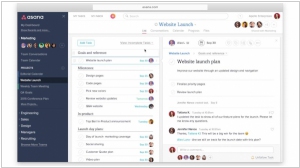
Asana, the renowned productivity and collaboration service, has secured a significant $75 million investment in its Series D funding round. In a blog post, Asana highlighted that 45 percent of its 30,000 paying customers are located outside of the United States. Among its notable clientele are prominent names like Tesco, Sky, Danone, Chanel, and Spotify. With this global reach in mind, Asana has announced its plans to introduce Spanish, Portuguese, and Japanese versions of its service, following the recent rollout of support for French and German. Including this latest funding, Asana has now successfully raised a total of $168 million from investors. Business Insider reported that the startup's current valuation stands at an impressive $900 million.
2017. Facebook Workplace gets standalone mobile apps
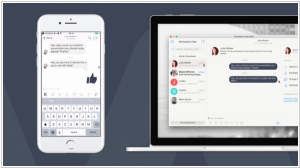
The business-oriented version of Facebook, known as Facebook Workplace, has made a significant update by introducing a separate app for desktop and mobile called Workplace Chat, dedicated solely to messaging functionalities. This move allows Workplace users to conveniently access various messaging features, such as screen and file sharing, private and group messages, and video calling, all within a single application. Speaking of video calling, Facebook has plans to incorporate group video calling into Workplace's array of messaging capabilities in the near future. It is worth noting that Facebook Workplace has witnessed considerable growth, with over 30,000 businesses and organizations currently utilizing the platform. This number has more than doubled compared to what Workplace reported six months ago, and prominent names like Starbucks, Spotify, Lyft, and Walmart are among its user base.
2017. Facebook Workplace gets desktop app
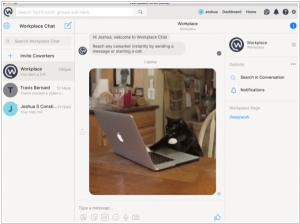
Facebook has fulfilled the long-standing request of its users by launching official desktop PC and Mac chat apps that include the highly desired features of screen sharing. Currently, these apps are exclusively available for Workplace, Facebook's enterprise collaboration software, which directly competes with other business applications like Slack. With over 14,000 businesses already utilizing Workplace and paying a fee of $1 to $3 per user, the recent addition of Wal-Mart to its client base further strengthens its position. The introduction of screensharing has the potential to attract more clients to Workplace by offering a superior alternative to the cumbersome screensharing options found in apps such as Skype and WebEx. Facebook's approach of swiftly developing an all-in-one collaboration app signifies its determination to dominate the office space, unlike its competitors who only provide fragmented solutions.

